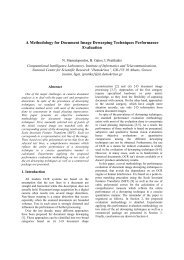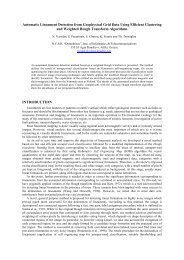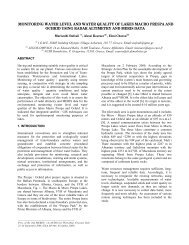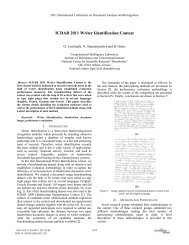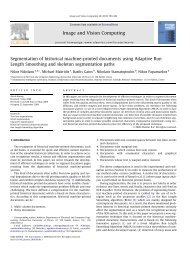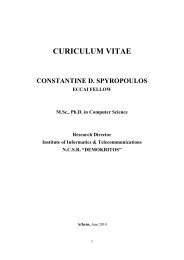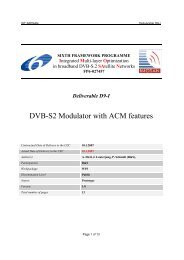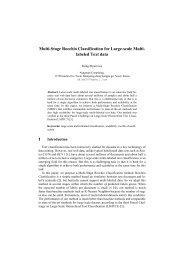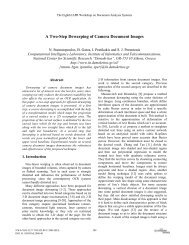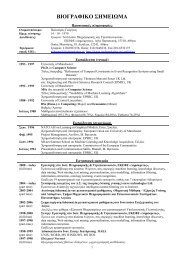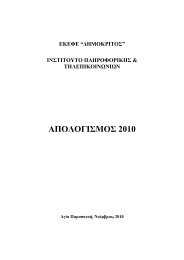TMS320C6713B Floating-Point Digital Signal Processor (Rev. A)
TMS320C6713B Floating-Point Digital Signal Processor (Rev. A)
TMS320C6713B Floating-Point Digital Signal Processor (Rev. A)
Create successful ePaper yourself
Turn your PDF publications into a flip-book with our unique Google optimized e-Paper software.
multichannel audio serial port (McASP) peripherals (continued)<br />
SPRS294A − OCTOBER 2005 − REVISED NOVEMBER 2005<br />
supported bit stream formats for TDM and burst transfer modes<br />
The serial data pins support a wide variety of formats. In the TDM and burst synchronous modes, the data may<br />
be transmitted / received with the following options:<br />
Time slots per frame: 1 (Burst/Data Driven), or 2,3...32 (TDM/Time-Driven).<br />
Time slot size: 8, 12, 16, 20, 24, 28, 32 bits per time slot<br />
Data size: 8, 12, 16, 20, 24, 28, 32 bits (must be less than or equal to time slot)<br />
Data alignment within time slot: Left- or Right-Justified<br />
Bit order: MSB or LSB first.<br />
Unused bits in time slot: Padded with 0, 1 or extended with value of another bit.<br />
Time slot delay from frame sync: 0,1, or 2 bit delay<br />
The data format can be programmed independently for transmit and receive, and for McASP0 vs. McASP1. In<br />
addition, the McASP can automatically re-align the data as processed natively by the DSP (any format on a<br />
nibble boundary) adjusting the data in hardware to any of the supported serial bit stream formats (TDM, Burst,<br />
and DIT modes). This reduces the amount of bit manipulation that the DSP must perform and simplifies software<br />
architecture.<br />
digital audio interface transmitter (DIT) transfer mode (transmitter only)<br />
The McASP transmit section may also be configured in digital audio interface transmitter (DIT) mode where it<br />
outputs data formatted for transmission over an S/PDIF, AES-3, IEC-60958, or CP-430 standard link. These<br />
standards encode the serial data such that the equivalent of ’clock’ and ’frame sync’ are embedded within the<br />
data stream. DIT transfer mode is used as an interconnect between audio components and can transfer<br />
multichannel digital audio data over a single optical or coaxial cable.<br />
From an internal DSP standpoint, the McASP operation in DIT transfer mode is similar to the two time slot TDM<br />
mode, but the data transmitted is output as a bi-phase mark encoded bit stream with preamble, channel status,<br />
user data, validity, and parity automatically stuffed into the bit stream by the McASP module. The McASP<br />
includes separate validity bits for even/odd subframes and two 384-bit register file modules to hold channel<br />
status and user data bits.<br />
DIT mode requires at minimum:<br />
One serial data pin (if the AUXCLK is used as the reference [see the PLL and Clock Generator Logic<br />
Figure 15]) or<br />
One serial data pin plus either the AHCLKX or ACLKX pin (if an external clock is needed).<br />
If additional serial data pins are used, each McASP may be used to transmit multiple encoded bit streams (one<br />
per pin). However, the bit streams will all be synchronized to the same clock and the user data, channel status,<br />
and validity information carried by each bit stream will be the same for all bit streams transmitted by the same<br />
McASP module.<br />
The McASP can also automatically re-align the data as processed by the DSP (any format on a nibble boundary)<br />
in DIT mode; reducing the amount of bit manipulation that the DSP must perform and simplifies software<br />
architecture.<br />
POST OFFICE BOX 1443 • HOUSTON, TEXAS 77251−1443<br />
87



